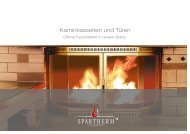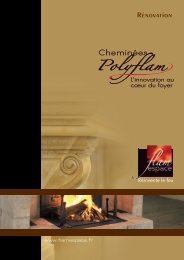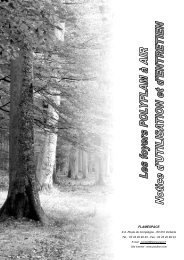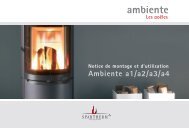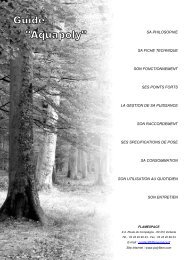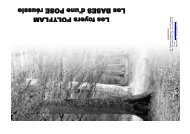Notice d'utilisation foyers vitrés - Flamespace
Notice d'utilisation foyers vitrés - Flamespace
Notice d'utilisation foyers vitrés - Flamespace
You also want an ePaper? Increase the reach of your titles
YUMPU automatically turns print PDFs into web optimized ePapers that Google loves.
5.9.2 CLOSED FIREPLACE UNITS<br />
For fireplace units that are intended to dissipate heat via the outer<br />
fireplace facing (masonry heater, hypocaustic system, systems with<br />
closing convection air openings, etc.), and therefore dissipate heat<br />
into the room via the facing, it is essential to observe the following<br />
points:<br />
• The fireplace unit must be dimensioned and built according to<br />
the relevant, professional tile fireplace and ventilation engineer<br />
guidelines (new: TR OL 2006).<br />
• We recommend using sufficient storage material (e.g. Magnatherm)<br />
to optimally use the heat and avoid the risk of overheating in temperature<br />
spikes.<br />
• The size of the oven, i.e. the size of the heat dissipating surface,<br />
should be determined depending on the heat output and heat requirement.<br />
• The facing elements must be selected to meet the higher standards.<br />
• The builder should provide written instructions on the special type/<br />
means of operation to the operator if possible. The quantity of wood<br />
used has to correspond to the heat dissipation of the surface or the<br />
storage capacity of the storage medium, for example (in general,<br />
stoke no more than 2 – 3/day).<br />
• We recommend protecting installation surfaces made of combustible<br />
construction materials with active rear ventilation in addition to<br />
the thermal insulation specified.<br />
• The insulation thicknesses listed on page 11 apply to warm air heating<br />
systems only. For closed fireplace units, the insulation thicknesses<br />
have to be calculated as per TR OL.<br />
• For liftable combustion chamber doors, the temperature on the reverse<br />
or guiding rollers and the bearings must not exceed 270 °C.<br />
And areas of the insert that have movable mechanical parts require<br />
separate insulation.<br />
• When installing accessory parts, observe their installation specification,<br />
especially the permissible operating or ambient temperatures and accessibility<br />
requirements, if any.<br />
This applies to the following models (Linear and Prestige):<br />
Mini: R1V/R1Vh, Z1, Z1 mit NSHF, 2L/2R/2LRh,<br />
Z1 H 2O/Z1h H 2O, Z1 H 2O XL/Z1h H 2O XL, S/Sh, S-FDh<br />
Speedy: 1V/1Vh, 1V/1Vh mit NSHF, M/Mh, K/Kh, K/Kh mit NSHF,<br />
Eh, Eh mit NSHF, MR/MRh, MR/MRh mit NSHF, R/Rh,<br />
R/Rh mit NSHF, Ph, MDRh, RDRh,<br />
Varia: 1V/1Vh, 1V H 2O/1Vh H 2O, 1V H 2O XL/1Vh H 2O XL, 1V<br />
H 2O XXL/1Vh H 2O XXL, 2L/2R/2Lh/2Rh, 2Lh H 2O/2Rh<br />
H 2O, 2L-100h/2R-100h, 2LRh/2RRh, Ch, FD/FDh, Ah,<br />
A-FDh, Sh/SRh (GT), Eh, BEh, Bh, B-FDh, B-120h, M-60h,<br />
M-80h, M-100h,<br />
Arte: 1Vh, Bh, BRh, Xh, X-FDh, 3RL-60h, 3RL-80h, 3RL-100h,<br />
U-50h, U-70h, U-90h, Wh<br />
GB 14



